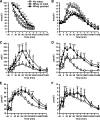Effects of a protein preload on gastric emptying, glycemia, and gut hormones after a carbohydrate meal in diet-controlled type 2 diabetes
- PMID: 19542012
- PMCID: PMC2732158
- DOI: 10.2337/dc09-0723
Effects of a protein preload on gastric emptying, glycemia, and gut hormones after a carbohydrate meal in diet-controlled type 2 diabetes
Abstract
Objective: We evaluated whether a whey preload could slow gastric emptying, stimulate incretin hormones, and attenuate postprandial glycemia in type 2 diabetes.
Research design and methods: Eight type 2 diabetic patients ingested 350 ml beef soup 30 min before a potato meal; 55 g whey was added to either the soup (whey preload) or potato (whey in meal) or no whey was given.
Results: Gastric emptying was slowest after the whey preload (P < 0.0005). The incremental area under the blood glucose curve was less after the whey preload and whey in meal than after no whey (P < 0.005). Plasma glucose-dependent insulinotropic polypeptide, insulin, and cholecystokinin concentrations were higher on both whey days than after no whey, whereas glucagon-like peptide 1 was greatest after the whey preload (P < 0.05).
Conclusions: Whey protein consumed before a carbohydrate meal can stimulate insulin and incretin hormone secretion and slow gastric emptying, leading to marked reduction in postprandial glycemia in type 2 diabetes.
Figures

Similar articles
-
A Protein Preload Enhances the Glucose-Lowering Efficacy of Vildagliptin in Type 2 Diabetes.Diabetes Care. 2016 Apr;39(4):511-7. doi: 10.2337/dc15-2298. Epub 2016 Jan 19. Diabetes Care. 2016. PMID: 26786576 Clinical Trial.
-
Title: Differentiating the effects of whey protein and guar gum preloads on postprandial glycemia in type 2 diabetes.Clin Nutr. 2019 Dec;38(6):2827-2832. doi: 10.1016/j.clnu.2018.12.014. Epub 2018 Dec 14. Clin Nutr. 2019. PMID: 30583967
-
Effects of a D-xylose preload with or without sitagliptin on gastric emptying, glucagon-like peptide-1, and postprandial glycemia in type 2 diabetes.Diabetes Care. 2013 Jul;36(7):1913-8. doi: 10.2337/dc12-2294. Epub 2013 Jan 28. Diabetes Care. 2013. PMID: 23359361 Free PMC article. Clinical Trial.
-
Cystic fibrosis related diabetes--a new perspective on the optimal management of postprandial glycemia.J Diabetes Complications. 2014 Nov-Dec;28(6):904-11. doi: 10.1016/j.jdiacomp.2014.06.012. Epub 2014 Jun 21. J Diabetes Complications. 2014. PMID: 25060530 Review.
-
Is glucagon-like peptide 1 an incretin hormone?Diabetologia. 1999 Mar;42(3):373-9. doi: 10.1007/s001250051165. Diabetologia. 1999. PMID: 10096792 Review.
Cited by
-
Dietary Aspects to Incorporate in the Creation of a Mobile Image-Based Dietary Assessment Tool to Manage and Improve Diabetes.Nutrients. 2021 Apr 2;13(4):1179. doi: 10.3390/nu13041179. Nutrients. 2021. PMID: 33918343 Free PMC article. Review.
-
Anekomochi glutinous rice provides low postprandial glycemic response by enhanced insulin action via GLP-1 release and vagal afferents activation.J Physiol Sci. 2024 Sep 27;74(1):47. doi: 10.1186/s12576-024-00940-5. J Physiol Sci. 2024. PMID: 39333851 Free PMC article.
-
Secretion of glucagon-like peptide-1 (GLP-1) in type 2 diabetes: what is up, what is down?Diabetologia. 2011 Jan;54(1):10-8. doi: 10.1007/s00125-010-1896-4. Epub 2010 Sep 25. Diabetologia. 2011. PMID: 20871975 Review.
-
Wheat Protein Hydrolysate Fortified With l-Arginine Enhances Satiation Induced by the Capsaicinoid Nonivamide in Moderately Overweight Male Subjects.Mol Nutr Food Res. 2019 Dec;63(23):e1900133. doi: 10.1002/mnfr.201900133. Epub 2019 Oct 2. Mol Nutr Food Res. 2019. PMID: 31535460 Free PMC article. Clinical Trial.
-
Effects of dairy intake on hyperuricemia and gout.Curr Rheumatol Rep. 2011 Apr;13(2):132-7. doi: 10.1007/s11926-010-0160-8. Curr Rheumatol Rep. 2011. PMID: 21188562 Review.
References
-
- Rayner CK, Samsom M, Jones KL, Horowitz M: Relationships of upper gastrointestinal motor and sensory function with glycemic control. Diabetes Care 2001; 24: 371– 381 - PubMed
-
- Bowen J, Noakes M, Trenerry C, Clifton PM: Energy intake, ghrelin, and cholecystokinin after different carbohydrate and protein preloads in overweight men. J Clin Endocrinol Metab 2006; 91: 1477– 1483 - PubMed
-
- Gentilcore D, Chaikomin R, Jones KL, Russo A, Feinle-Bisset C, Wishart JM, Rayner CK, Horowitz M: Effects of fat on gastric emptying of and the glycemic, insulin, and incretin responses to a carbohydrate meal in type 2 diabetes. J Clin Endocrinol Metab 2006; 91: 2062– 2067 - PubMed
-
- Horowitz M, Edelbroek MA, Wishart JM, Straathof JW: Relationship between oral glucose tolerance and gastric emptying in normal healthy subjects. Diabetologia 1993; 36: 857– 862 - PubMed
Publication types
MeSH terms
Substances
LinkOut - more resources
Full Text Sources
Other Literature Sources
Medical

